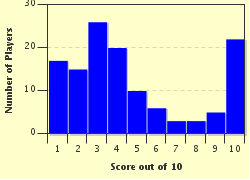Quiz Answer Key and Fun Facts
1. Which of the following is a paramagnetic substance?
2. What is the number of electrons present in the nucleus of an uranium atom having atomic number 92 and mass number 238?
3. In which year did Max Planck introduce his quantum theory?
4. Which of the following is an example of a third class lever?
5. Which of these is a dielectric material?
6. What is the boiling point of water on the Rankine scale?
7. Which elementary particle is also known as the 'positive electron'?
8. During an adiabatic process, which of these remains constant?
9. Who discovered the phenomenon of superconductivity?
10. For what purpose is a Pitot tube used?
Source: Author
ABHILASHA40
This quiz was reviewed by FunTrivia editor
rossian before going online.
Any errors found in FunTrivia content are routinely corrected through our feedback system.

